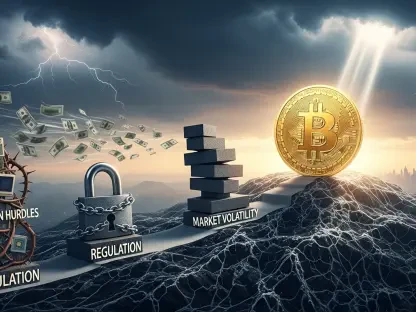In a rapidly evolving digital landscape, the dynamic relationship between PayPal and blockchain technology exemplifies the shifting paradigms within the fintech sector. Established as a leading digital wallet, PayPal has long provided users with a convenient and secure platform for online transactions. Meanwhile, blockchain technology, best known as the backbone for cryptocurrency transactions, has introduced a decentralized approach to financial exchanges that promises transparency and security. This article discusses the fundamental differences between PayPal and blockchain, examines their current coexistence, and explores the challenges that lie ahead as they navigate a hybrid future.
Fundamental Differences Between PayPal and Blockchain
PayPal operates as a centralized system, serving as an intermediary that facilitates the storage, management, and transfer of funds from a user’s bank account or credit/debit cards. This centralization ensures that transactions are meticulously monitored and safeguarded, providing users with the advantages of near-instant transactions, rigorous cybersecurity measures, and the convenience of linking bank accounts, maintaining a PayPal balance, and utilizing PayPal Credit. PayPal’s services are not limited to online purchases; they also extend to offline transactions through point-of-sale machines, reflecting its all-encompassing utility.
Conversely, blockchain technology introduces a decentralized framework that powers cryptocurrency transactions, characterized by secure, transparent, and immutable records. Decentralization involves a distributed ledger system where transaction data is stored across various nodes, each known as a block, linked permanently in a way that enhances the security and integrity of transactions. This system negates the need for central authority oversight, thereby offering enhanced anonymity and making it significantly challenging for transactions to be traced or regulated by traditional financial institutions or government entities.
Security and Anonymity: Centralized vs. Decentralized
One of PayPal’s standout features is its strong emphasis on security through centralized tracking and regulation, achieved in part through compliance with financial institutions and governmental agencies. This centralization ensures that transactions are systematically monitored, significantly reducing the risk of fraud and providing users with considerable peace of mind regarding the security and legitimacy of their financial activity. However, this security comes with a trade-off: transactions are subject to rigorous oversight and regulation by central authorities, which may affect user privacy.
In stark contrast, blockchain technology capitalizes on its decentralized nature to offer enhanced anonymity and security. Transactions within blockchain networks are secure and transparent, but they are far from easily traceable, painting an attractive picture for those who prioritize privacy in their financial dealings. The decentralized ledger system ensures that no single entity has control over the entire blockchain, diminishing the ability of any central authority to regulate or oversee transactions comprehensively. This unique feature appeals especially to tech-savvy and privacy-conscious users, even as it presents regulatory challenges to traditional financial institutions.
User Adoption and Trends in Fintech
As blockchain technology continues to garner widespread attention and adoption, PayPal has proactively integrated elements of this technology into its existing services. This strategic move has allowed its users to embrace the world of cryptocurrencies, granting them the ability to buy, hold, and sell various digital currencies through PayPal’s platform. This shift underscores PayPal’s keen awareness of emerging trends and its willingness to adapt its business model to retain its edge in the increasingly competitive fintech landscape.
Despite the meteoric rise of blockchain, the traditional business model of gateways like PayPal faces significant challenges. There is widespread speculation that the sophisticated, decentralized nature of blockchain could potentially overshadow conventional payment methods in the future. This is due in large part to blockchain’s technological advancements and an expanding user base drawn to its features. Nonetheless, PayPal’s deliberate integration of blockchain components illustrates its resilience and commitment to remaining a formidable player in the fintech realm, with a clear strategy for future-proofing its services against the backdrop of a rapidly digitizing world.
Cryptocurrency in Online Transactions
The rising tide of cryptocurrency usage in online transactions is becoming increasingly evident in diverse sectors including online gaming and casino platforms. This growing acceptance signals a broader shift in consumer preferences toward instant, secure, and cost-effective payment methods. In response to this burgeoning demand, PayPal has enhanced its service capabilities to support a variety of cryptocurrency transactions, ensuring that it remains an indispensable tool for modern financial exchanges.
By integrating cryptocurrencies such as Bitcoin (BTC), Bitcoin Cash (BCH), Litecoin (LTC), Ethereum (ETH), and its own PayPal USD (PYUSD), PayPal has visibly demonstrated its commitment to staying relevant in an ever-evolving fintech landscape. These enhancements not only cater to the burgeoning base of cryptocurrency users but also serve to retain PayPal’s loyal customer base, highlighting its proactive adaptation to the shifting dynamics of financial technology. As more transactions migrate online and user expectations evolve, PayPal’s capability to handle these diverse payment options solidifies its position as a versatile and future-ready digital wallet.
Challenges and Changes Ahead
Adapting to the fast-paced world of blockchain and decentralized finance (DeFi) presents PayPal with a unique set of challenges. The enterprise must substantially rethink its business model, strategies, and marketing approaches to better resonate with the growing number of crypto enthusiasts while still serving its existing clientele. This strategic pivot necessitates blending the traditional, centralized operational framework with the innovative, decentralized attributes of blockchain—a complex endeavor that requires a careful balancing act.
The principal challenge for PayPal lies in harnessing the benefits of blockchain without compromising the security, convenience, and ease of use that its users expect. The process of integrating decentralized elements into a primarily centralized system is fraught with both technical and perceptual hurdles. PayPal must identify ways to offer the enhanced security and anonymity of blockchain transactions while maintaining robust regulatory compliance and user trust. Successfully navigating this transitional period will be crucial for PayPal to maintain its competitive advantage and relevance in the dynamic world of fintech.
Consensus Viewpoints on the Future of Fintech
In today’s fast-changing digital world, the evolving relationship between PayPal and blockchain technology illustrates the shifting dynamics within the fintech industry. PayPal, a well-established digital wallet, has long offered users a reliable and secure platform for online transactions. On the other hand, blockchain technology, primarily recognized as the foundation for cryptocurrency exchanges, has introduced a decentralized method of financial transactions, promising increased transparency and security. This piece delves into the key differences between PayPal and blockchain, scrutinizes their present coexistence, and considers the potential challenges they may encounter as they adapt to a future where both systems might blend. Blockchain’s decentralization starkly contrasts with PayPal’s centralized model, making their interplay a significant point of interest. Furthermore, as blockchain gains more mainstream acceptance, it could reshape how PayPal and similar platforms operate. The journey ahead involves navigating integration, regulatory landscapes, and the ever-evolving demands of digital finance.









